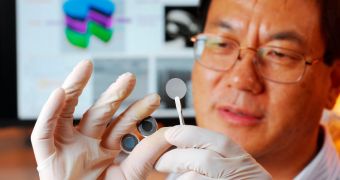A team of experts from the Georgia Institute of Technology (Georgia Tech) announces the creation of a power cell that is capable of charging itself by converting mechanical energy into chemical energy.
The latter is then stored inside the device until it can be released as electrical current. This approach is capable of utilizing mechanical energy for electricity production more efficiently than systems that use generators and batteries.
Those systems have to convert mechanical energy to electrical energy directly, and they can only do so at the cost of efficiency. By eliminating this need, the research group was able to generate a hybrid generator-storage cell.
The most important component in the system is a membrane made out of a piezoelectric material. The latter can be certain types of either ceramics or crystals, and their most important property is that they produce an electrical current when their shape is changed.
Similarly, when a current is applied to their surface, they change their shape. In this power cell, the purpose of the piezoelectric membrane is to move lithium ions from one side of the device to the other, whenever it is deformed via mechanical stress.
An electrochemical process is then used to directly store the lithium ions as chemical energy, ready to be recalled and used whenever they are needed. At this time, the device produces sufficient electricity to power a small calculator.
Scientists behind the innovation say that the power cell can be inserted in the heels of shoes, for example, allowing people to recharge their tablets, smartphones, and even laptops, as they walk.
“People are accustomed to considering electrical generation and storage as two separate operations done in two separate units,” Georgia Tech School of Materials Science and Engineering Regents Professor, Zhong Lin Wang, explains.
“We have put them together in a single hybrid unit to create a self-charging power cell, demonstrating a new technique for charge conversion and storage in one integrated unit,” he goes on to say.
Details of how the power cell works were published in the August 9 issue of the esteemed journal Nano Letters, in a paper entitled “Hybridizing Energy Conversion and Storage in a Mechanical-to-Electrochemical Process for Self-Charging Power Cell.”
Funds for the research came from the Defense Advanced Research Projects Agency (DARPA), the US National Science Foundation (NSF), the Department of Energy's (DOE) Office of Basic Energy Sciences and the Chinese Academy of Sciences' (CAS) Knowledge Innovation Program.

 14 DAY TRIAL //
14 DAY TRIAL //